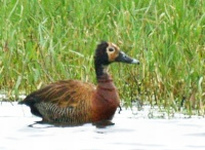
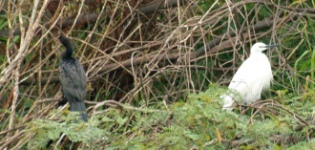
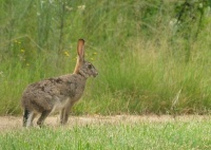
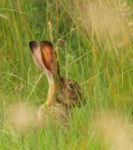
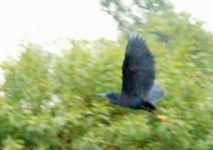
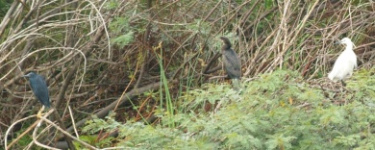
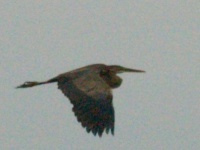
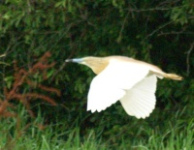
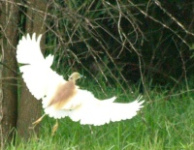
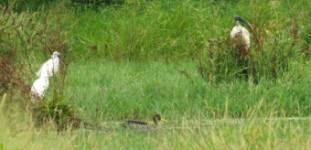
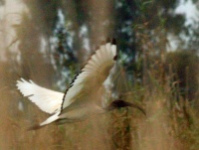
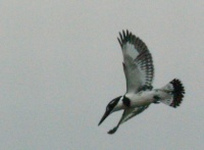
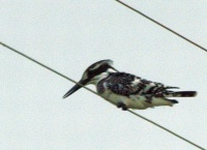
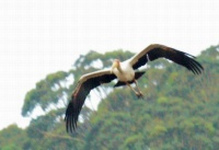
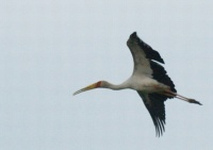
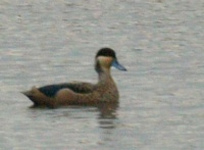
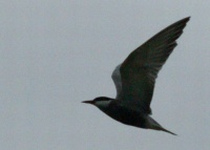
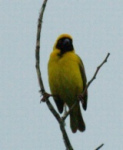
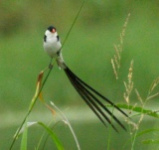
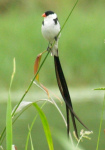
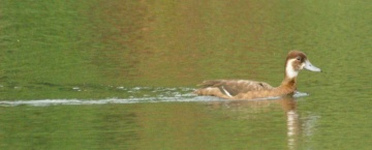
Trip 1 - January 2010
Just outside the town of Carltonville lies an amazing and diverse nature reserve called Abe Bailey Nature Reserve (chapter 80 in Birding Gauteng). On an overcast day I spent a few hours exploring the various habitats including open grasslands, wetlands and a stream. Visitors gain entrance at the security gate and head to the main offices to pay an entrance fee (just R5 per person adn R5 per car). Here are some of the pics that I took on the day:
Trip 2 - August 2011
On Monday the 8th August 2011 I headed off to explore the Abe Bailey Nature Reserve in Carltonville. I visited the spot in January 2010 but to be honest I had just started birding and had no clue as to what I was doing or what I was seeing. I arrived as the sun was rising and headed down to the wetland but it was freezing cold and decided to drive straight through the wetland and explore the higher lying grasslands. I was able to spend about ten to fifteen minutes out of the car at a time before having to jump back in, drink some coffee and keep moving with the heater on. Fortunately there was a good amount of birds around to keep me focussed and willing to brave the cold.
Here are a few scenery shots of the grasslands in this area of the reserve:
Within minutes of making my way from the office area to the grasslands I had Lark sightings. I was able to positively identify Spike-heeled and Easter Clapper - and one possible sighting of Melodious Lark which responded to the call I played but disappeared so it won't be counted for this trip.
The place is alive with Northern Black Korhaan (the Reserve Manager says that he has counted over 30 birds that live there) as well as Orange River Francolin which I heard calling all morning but never even got a glimpse of one. A few Pipits were seen but most likely they were all African Pipit.
A huge highlight was spotting a Secretarybird in the road about 50 meters in front of me and sneaking up on it before it took off and flew away from me. That was the first time that I have ever seen a Secretarybird fly - who would have thought these giants can actually take off and fly?
By 9:30 I had completed the drive through the northern section of the reserve and arrived at the lookout spot over the eastern most part of the wetland. I would discover on the day that the wetland practically goes on forever and would get to explore it's entire length - nearly dying of thirst in the process (with water all around) as I chose to cover it on foot leaving my car with my flask of coffee and water bottle waiting for my return. Here are some shots of this first quarter of the wetland:
The place was not teeming with water fowl but there was more than enough in the reeds and the surround bush to keep me interested. Here is a selection of sightings:
I managed to get fairly close to a Purple Heron that was waiting for a snack in the shallow water:
I walked along the tar road that leads through the wetland and then started to make my way downstream. There are endless paths around the water's edge and it is possible to get right up to the wetland in countless places - making for great opportunities to see what is lurking in the reeds and on the water's edge. Here are some scenery shots of the second quarter of the wetland (there is a stunning rock formation which would be an ideal platform to scan the wetland from, but I tried from all angle but without rock climbing gear I concluded that I would be risking my life if I climbed to the top).
The various pairs of South African Shelduck on the wetland were honking at the top of their voices the whole time that I was there and flying around whenever I would get too close to the water's edge. Waders were well represented on the day with sightings of Three-Banded Plover, Wood Sandpiper, Marsh Sandpiper and Ruff. All the Teal duck species were spotted including Red-billed, Hottentot and Cape. Here are some pics of bird sightings from this area:
I then began to explore what I thought was the final section of the wetland (but I would discover much later that it was actually just the third quarter). Here is a selection of photos that I took in this quarter of the wetland:
Here are a few pics that are worth showing from this section to record what I saw rather than wow any audience. It was hard on the wetland to sneak up on the water fowl as there is little cover and they would see me coming long before I saw them most of the time:
I got back to my car, wolfed down my sandwiches and some coffee and decided to drive back to the end of the wetland to see if I had missed any water fowl. On the way I got two separate sightings of Orange River Francolin (more than I had gotten all morning although I heard them calling all over the grasslands).
As I got to what I had previously thought was the end of the wetland I saw that the road continued further west and this led to two more huge water bodies with stunning scenery. There is actually no fence or gate at the eastern end of the reserve near to Khutsong but the manager says that apart from theft of building material from the property on a few occasions there has never been a security risk to guests. It is still necessary to take care while birding on the western sections of the property.
This part of the wetland so close to the township was rather lively - with a number of fishermen trying to catch fish, herdsmen with their goats and cattle as well as a car wash service. I spent some time explaining to some of the chaps what I was doing there and they showed great interest when I showed them pics of the birds on the dam in my Roberts book. I doubt they have become birders, but hopefully they are more aware of the importance of the area - not just for fishing and watering their livestock! I must say that this part of the wetland has some of the most spectacular views as these scenery pics show:
Here is a selection of pics from this quarter of the wetland:
I decided to leave the reserve along the road back to Carltonville and not drive all the way back through the reserve. I made my way to what is signposted as the "Oog van Wonderfontein" - hoping to discover the source of the water that is running into the wetland. Before I solved that mystery I screeched to a halt when I saw an Orange River Francolin strolling in clear view next to the road. I was able to pull up alongside, snap some pics and watch it join another bird before heading down the slope to the water that seemed to be running in a canal.
I spotted a farm on the wetland in the valley and asked permission to bird the area. I was also told that the water comes from the mine that is operating nearby. Here are some scenery shots of this area:
I returned to the tar road and made my way to the bird where the river crosses towards the Reserve. There is good wetland here on either side of the road - but I saw the most bird life on the western side of the road. Here are some pics of the scenery and birds on the wetland at this point:
Here is a selection of pics that I took of mammals and other biodiversity in the reserve:
In total I saw at least 85 bird species - here is a full list of the birds that I spotted: Acacia Pied Barbet; African Black Duck; African Darter; African Pipit; African Quailfinch; African Reed Warbler; African Snipe; Ant-eating Chat; Arrow-marked Babbler; Black Crake; Black-chested Prinia; Black-headed Heron; Black-shouldered Kite; Blacksmith Lapwing; Black-throated Canary; Black-winged Stilt; Blue Waxbill; Bokmakierie; Burchell's Coucal; Cape Longclaw; Cape Shoveler; Cape Sparrow; Cape Teal; Cape Turtle-Dove; Cape Wagtail; Capped Wheatear; Cattle Egret; Cloud Cisticola; Common Fiscal; Common Moorhen; Common Myna; Crested Barbet; Crowned Lapwing; Dark-capped Bulbul; Eastern Clapper Lark; Egyptian Goose; Glossy Ibis; Great Crested Grebe; Hadeda Ibis; Helmeted Guineafowl; Hottentot Teal; Laughing Dove; Lesser Swamp Warbler; Levaillant's Cisticola; Little Grebe; Little Swift; Long-tailed Widowbird; Malachite Kingfisher; Marsh Sandpiper; Neddicky; Northern Black Korhaan; Orange River Francolin; Orange-breasted Waxbill; Pied Avocet; Pied Starling; Pin-tailed Whydah; Purple Heron; Red-billed Firefinch; Red-billed Quelea; Red-billed Teal; Red-eyed Dove; Red-headed Finch; Red-knobbed Coot; Reed Cormorant; Ruff; Rufous-naped Lark; Sacred Ibis; Secretarybird; South African Shelduck; Southern Masked Weaver; Southern Pochard; Southern Red Bishop; Speckled Mousebird; Speckled Pigeon; Spike-heeled Lark; Spur-winged Goose; Swainson's Spurfowl; Tawny-flanked Prinia; Thick-billed Weaver; Three-banded Plover; White-browed Sparrow-Weaver; White-faced Duck; White-throated Swallow; Wood Sandpiper and Yellow-billed Duck.